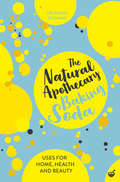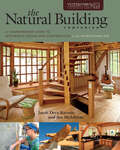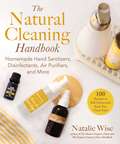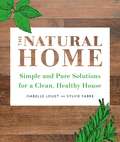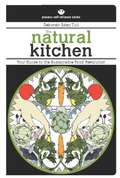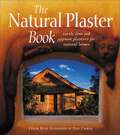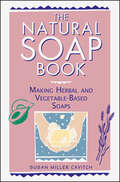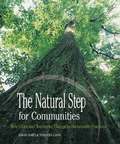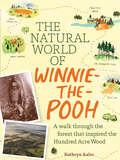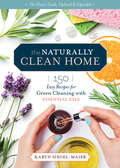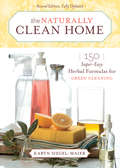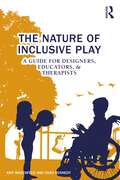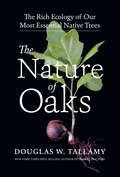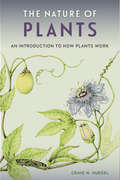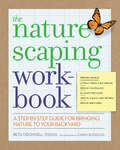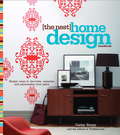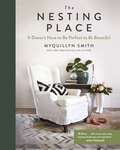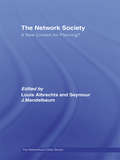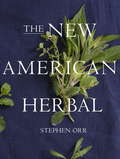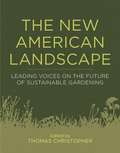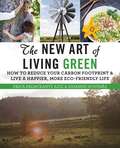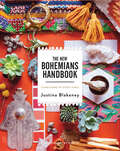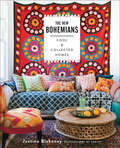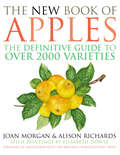- Table View
- List View
The Natural Apothecary: Tips for Home, Health and Beauty (Nature's Apothecary Ser. #3)
by Dr. Penny StanwayA pocket guide to harnessing the power of bicarbonate of soda to use as a home remedy, beauty aid and household resource.Not just for cakes, bicarbonate of soda has long been recognised as a hero ingredient for anyone looking to make their own eco-friendly cleaners and beauty products. Made up of tiny crystals, bicarb’s natural structure makes it the perfect gentle abrasive for home cleaning, and its natural antacid properties are ideal for tackling heartburn or creating antibacterial cosmetics at home.With our increasing awareness of reducing exposure to chemicals and the importance of keeping things natural, as well as the ever-growing realization of the environmental impact of disposable plastic packaging, there has never been a better time to go back to basics, embrace natural ingredients and regain control of what we are putting in our homes and on our bodies. The Natural Apothecary: Bicarbonate of Soda opens by exploring what bicarbonate of soda is made up of, and how it can be both naturally occurring and manufactured. The following pages are broken into sections on home, health and beauty, containing over 40 simple recipes for all-natural, home-made products that allow you to utilize the power of bicarbonate of soda with ease; make a soothing drink to ease indigestion, an all-natural exfoliating scrub to smooth your skin, or a simple but effective stain remover to leave your clothes looking like new.
The Natural Building Companion: A Comprehensive Guide to Integrative Design and Construction
by Jacob Deva Racusin Ace Mcarleton"Fun. Easy to Read...One of the best natural building books published in recent years."—Bill Steen, coauthor, The Straw Bale HouseNatural buildings not only bring satisfaction to their makers and joy to their occupants, they also leave the gentlest footprint on the environment. In this complete reference to natural building philosophy, design, and technique, Jacob Deva Racusin and Ace McArleton walk builders through planning and construction, offering step-by-step instructions on:• siting and site analysis• choosing materials• integrating basic structural considerations into a design• strategies for heating/cooling efficiency and moisture management• planning for acoustics• developing an integrative design• navigating budgeting, code compliance, and project management• creating the foundation, wall system, roof, and floors• selecting and making plasters and paints• evaluating options for mechanical and utility systems• protecting against fire and insects• integrating structures within landscape, climate, and human communities...and moreApplicable to building in climates that are cold and wet, hot and dry, or somewhere in-between, The Natural Building Companion provides the tools necessary to understand basic principles of building science, including structural and thermal engineering, and hydrodynamics. This guide offers thorough, up-to-date, and advanced installation details and performance characteristics of straw-bale, straw-clay, woodchip-clay, and cellulose wall systems, as well as earthen and stone wall systems and a variety of framing, roofing, flooring, mechanical system, and finishing options. This fully-illustrated volume informs professionals making the transition from conventional building, homeowners embarking on their own construction, or green builders who want comprehensive guidance on natural-building options.
The Natural Cleaning Handbook: Homemade Hand Sanitizers, Disinfectants, Air Purifiers, and More
by Natalie WiseMake sanitizers, soaps, and all your personal hygiene needs to kill germs and keep you virus-free! These days, dangerous viruses can suddenly become rampant, and bacteria can adapt to become antibiotic-resistant, so we must be extra-vigilant about our health. The Natural Cleaning Handbook keeps you clean, naturally, with homemade products that are healthy for you and your family. Start with the basics and work your way into every corner of your home . . . from tile grout to shower mold, how to clean lampshades to how to clean water bottles. Germ-killing recipes for cleaning nearly every surface in your home from the carpet to stuffed animals include: Hand sanitizing spray, gel, and foamAntibacterial hand and surface wipesAir purifying sprayLiquid hand soapAnd so much more! You&’ll also learn storage and organization secrets to keep your home clutter-free, how to manage your time and budget, and why some old-fashioned remedies are still the modern organic ways to keep home. Now is the time to get started.
The Natural Home: Simple, Pure Cleaning Solutions and Recipes for a Healthy House
by Isabelle Louet Sylvie FabreA charming, comprehensive, and easy-to-use guide to cleaning your home naturally and organically, resulting in a toxin-free environment for you and your family. With THE NATURAL HOME, you'll discover how to clean everything in your house the healthy way with just a few inexpensive, easy-to-find products using tried and true cleaning methods that have been around for centuries. Organized by product and location in the home, the book includes an in-depth explanation of natural products like vinegar, lemon, and baking soda which can be used to clean most areas in your home. There's a cleaning guide by room; tips for maintaining materials like marble, stainless steel, and wood; solutions for every stain; natural fragrances for your home; laundry tips; and natural products for pets. Also included are recipes for cleaning products you can make on your own that will help disinfect, whiten, deodorize and remove even the toughest stains in bathrooms, kitchen, carpets, and clothing. Beautifully designed with two-color interiors and filled with dozens of illustrations, THE NATURAL HOME is a charming gift book that shows you how to keep your home sparkling, green, and healthy.
The Natural Kitchen: Your Guide to the Sustainable Food Revolution
by Deborah Eden TullThis quietly revolutionary guidebook picks up where the best-selling Process Self-Reliance Series' The Urban Homestead left off and brings us into the kitchen, where the daily choices we make involving food have a profound impact both on our lives and the world at large.<P><P>Deborah Eden Tull draws upon seven years of experience as a monk, organic farmer, and chef to introduce simple but life-changing ways for urbanites to adopt a more mindful relationship with food, including shopping, menu planning, cooking, growing and preserving food, and maintaining the kitchen.Beautifully illustrated, practical, and fun, this book is filled with anecdotes and step-by-step instructions to inspire neophytes and experienced homesteaders alike.The Natural Kitchen's introspective and educational journey will inspire action and change forever the way readers relate to food, the environment, and their daily lives.
The Natural Plaster Book: Earth, Lime and Gypsum Plasters for Natural Homes
by Dan Chiras Cedar Rose GuelberthFor builders of natural homes (straw bale, cob, adobe, rammed earth, and other natural materials), this unique step-by-step guide takes the confusion out of choosing, mixing, and applying natural plasters.From principles to practicalities, and with every stage of the process illustrated, The Natural Plasters Book details the entire process of plastering with earth, lime, and gypsum for a long-lasting and durable finish. Starting with an overview and history of the natural building movement, the book handles a wide variety of topics including earthen plaster versus cement stucco, tools and techniques of the trade, plaster recipes, and pigmenting plaster or painting walls with natural paints. First-time builders will appreciate tips on common mistakes (and how to avoid them) discussed at each stage of the plastering process. Special focus is paid to the importance of planning and designing for earthen plasters- before building begins.The only comprehensive guide available on natural plasters, this book is written for the growing number of people who have decided to build their own natural homes as well as for professionals. Heavily illustrated with practical drawings and photographs, it also includes an extensive resource guide listing books, magazines, videos, builders, and suppliers.
The Natural Soap Book: Making Herbal and Vegetable-Based Soaps
by Susan Miller CavitchMaking your own soap is fun, easy, and rewarding. In this introductory guide, Susan Miller Cavitch shows you how to craft your own all-natural, wonderfully smelling soaps. Illustrated directions take you through the whole process, from buying supplies to cutting the final bars. With easy-to-follow recipes that range from classics like oatmeal and honey soap to more adventurous combinations using goat milk and borage, you’ll be inspired to make uniquely personal soaps that are gentle on your skin and a pleasure for your nose.
The Natural Step for Communities
by Sarah James Torbjörn LahtiSustainability may seem like one more buzzword and cities and towns like the last places to change, but The Natural Step for Communities provides inspiring examples of communities that have made dramatic changes toward sustainability and explains how others can emulate their success.Chronicled in the book are towns like Övertorneå, whose government operations recently became 100 percent fossil fuel-free, demonstrating that unsustainable municipal practices really can be overhauled. Arguing that the process of introducing change--whether converting to renewable energy or designing compact development--is critical to success, the authors outline why well-intentioned proposals often fail to win community approval and why an integrated approach--not "single-issue" initiatives--can surmount challenges of conflicting priorities, scarce resources and turf battles.The book first clarifies the concept of sustainability, offering guiding principles--the Natural Step framework--that help identify sustainable action in any area. It then introduces the 60+ eco-municipalities of Sweden that have adopted changes to sustainable practices throughout municipal policies and operations. The third section explains how they did it and outlines how other communities in North America and elsewhere can do the same. Key to success is a democratic, "bottom-up" change process and clear guiding sustainability principles, such as the Natural Step framework.The book will appeal to both general readers wishing to understand better what sustainability means and practitioners interested in introducing or expanding sustainable development in their communities.Sarah James is the principal of a community planning consulting firm. She co-authored the American Planning Association's Planning for Sustainability Policy Guide and has published articles throughout the U.S. on this subject.Torbjörn Lahti was the planner for Sweden's first eco-municipality and is directing a five-year sustainable community demonstration project. He was instrumental in forming the Swedish National Association of Eco-municipalities.
The Natural World of Winnie-the-Pooh: A Walk Through the Forest that Inspired the Hundred Acre Wood
by Kathryn AaltoLoved “Goodbye Christopher Robin”? Learn more about the real place that inspired the beloved stories. Delve into the home of the world’s most beloved bear! The Natural World of Winnie-the-Pooh explores the magical landscapes where Pooh, Christopher Robin, and their friends live and play. The Hundred Acre Wood—the setting for Winnie-the-Pooh’s adventures—was inspired by Ashdown Forest, a wildlife haven that spans more than 6,000 acres in southeast England. In the pages of this enchanting book you can visit the ancient black walnut tree on the edge of the forest that became Pooh’s house, go deep into the pine trees to find Poohsticks Bridge, and climb up to the top of the enchanted Galleons Lap, where Pooh says goodbye to Christopher Robin. You will discover how Milne's childhood connection with nature and his role as a father influenced his famous stories, and how his close collaboration with illustrator E. H. Shepard brought those stories to life. This charming book also serves as a guide to the plants, animals, and places of the remarkable Ashdown Forest, whether you are visiting in person or from the comfort of your favorite armchair. In a delightful narrative, enriched with Shepard’s original illustrations, hundreds of color photographs, and Milne’s own words, you will rediscover your favorite characters and the magical place they called home.
The Naturally Clean Home, 3rd Edition: 150 Nontoxic Recipes for Cleaning and Disinfecting with Essential Oils
by Karyn Siegel-MaierIn this updated edition of her best-selling book, The Naturally Clean Home, Karyn Siegel-Maier brings together the formulas for home cleaning solutions that readers have trusted for years with new information and ingredients updated to today&’s green standards. A new introduction shines a light on the antiseptic properties of essential oils, addressing different grades of oil and their effectiveness against bacteria and viruses, as well as updated safety precautions and cost. Updated recipes eliminate Borax (banned as a food additive in the US and from cosmetic and cleaning products in the EU) from ingredient lists, replacing it with safe substitutes that include citric acid powder, hydrogen peroxide, diatomaceous earth, cornstarch, washing soda, and baking soda. New recipes show readers how to make easy, nontoxic, environmentally friendly substitutes for popular cleaning products, including molded laundry and dishwasher tablets. Packaging updates emphasize the use of glass containers for homemade cleaning products, to diminish environmental impact of plastic waste.
The Naturally Clean Home: 150 Super-Easy Herbal Formulas for Green Cleaning
by Karyn Siegel-MaierKeep your home clean, green, and healthy! Learn how to disinfect and freshen your house using powerful all-natural cleaners made by mixing essential oils together with common nontoxic kitchen ingredients like baking soda, lemon, and vinegar. Discover how fruits and herbs can brighten any room with revitalizing scents.
The Nature of Inclusive Play: A Guide for Designers, Educators, and Therapists
by Amy Wagenfeld Chad KennedyThis book provides designers, planners, educators, and therapists with the practical information required to remove inequity in outdoor spaces, by creating inviting and inclusive solutions so that all children and their families, regardless of situation or circumstance, can experience the joys and benefits of outdoor play without stigma. It is the first of its kind, co-written by an occupational therapist and landscape architect both with proven expertise in inclusive play space design. The Nature of Inclusive Play fills an untapped niche in promoting the value of outdoor play. It focuses on what embodies play and shows how, through inclusive outdoor play design, developmental skills can be enriched. The topics covered in the book include: • a discussion of the health benefits associated with being outdoors • the history of and value of play • an overview of typical child development • the importance of sensory regulation • an inclusive design review process • design guidelines. All topics are supplemented with nine applicable case studies of inclusive outdoor play spaces with features that reflect inclusive+ principles, including examples from North America and Africa. It is a much-needed guide for landscape architects, urban planners, allied health care professionals, early childhood educators, academics, and students.
The Nature of Oaks: The Rich Ecology of Our Most Essential Native Trees
by Douglas W. Tallamy&“A timely and much needed call to plant, protect, and delight in these diverse, life-giving giants.&” —David George Haskell, author of The Forest Unseen and The Songs of Trees With Bringing Nature Home, Doug Tallamy changed the conversation about gardening in America. His second book, the New York Times bestseller Nature&’s Best Hope, urged homeowners to take conservation into their own hands. Now, he is turning his advocacy to one of the most important species of the plant kingdom—the mighty oak tree. Oaks sustain a complex and fascinating web of wildlife. The Nature of Oaks reveals what is going on in oak trees month by month, highlighting the seasonal cycles of life, death, and renewal. From woodpeckers who collect and store hundreds of acorns for sustenance to the beauty of jewel caterpillars, Tallamy illuminates and celebrates the wonders that occur right in our own backyards. He also shares practical advice about how to plant and care for an oak, along with information about the best oak species for your area. The Nature of Oaks will inspire you to treasure these trees and to act to nurture and protect them.
The Nature of Plants: An Introduction to How Plants Work
by Craig N. HuegelChoice Outstanding Academic Title Florida Book Awards, Bronze Medal for General Nonfiction Plants play a critical role in how we experience our environment. They create calming green spaces, provide oxygen for us to breathe, and nourish our senses. In The Nature of Plants, ecologist and nursery owner Craig Huegel demystifies the complex lives of plants and provides readers with an extensive tour into their workings. Beginning with the importance of light, water, and soil, Huegel describes the process of photosynthesis and how best to position plants to receive optimal sunlight. He explains why plants suffer from overwatering, what essential elements plants need to flourish, and what important soil organisms reside with them. Readers will understand the difference between friendly and hostile bacteria, fungi, and insects. Sections on plant structure and reproduction focus in detail on major plant organs—roots, stems, and leaves—and cover flowering, pollination, fruit development, and seed germination. Huegel even delves into the mysterious world of plant communication, exploring the messages conveyed to animals or other plants through chemical scents and hormones. With color illustrations, photographs, and real-life examples from his own gardening experiences, Huegel equips budding botanists, ecologists, and even the most novice gardeners with knowledge that will help them understand and foster plants of all types.
The Naturescaping Workbook: A Step-by-Step Guide for Bringing Nature to Your Backyard
by Beth O'Donnell Young Karen BussoliniMuch of modern garden design is about controlling nature to achieve a desired effect. But for the eco-conscious homeowner, the best garden designer is Mother Nature, and following her lead can result in a beautiful low-maintenance landscape that requires fewer resources, attracts natural wildlife, and saves time and money. In The Naturescaping Workbook, author Beth O'Donnell Young sets forth an easy-to-follow, do-it-yourself plan for gardeners of all skill levels. Her step-by-step approach teaches gardeners to understand their own natural habitat and to nurture the native eco-systems that exist in their yard. And the payoff is huge. By simply becoming aware of the natural wonders in the backyard, anyone can gain a more beautiful garden and take a big step toward bringing nature home.
The Nautical Home: Coastline-Inspired Ideas to Decorate with Seaside Spirit
by Anna OrnbergAre you a beach bum, a beach lover, or simply just a fan of the water? If you find yourself constantly longing for a relaxing vacation along the sandy shores of Tahiti or yearning to go on a coast-to-coast cruise, look no further. Interior designer Anna Örnberg has all the solutions to bring the waves to your home and living room. With Anna’s advice and expertise, you can turn your own apartment or living space into a beautiful waterfront home. Live on the beach with nautical style and enjoy the waves. Using seashells, ropes, dark woods, and light-colored walls, the interior designs in this book remind readers of sunken ships and buried treasures. The decor will inspire homeowners to personalize their homes into the most calming and soothing living quarters, a place where they can sit, relax, and enjoy the ocean breeze. Projects include: Wooden lampshades Nautical placemats and pot holders Building your own lighthouse Beanbags and pillowcases The nautical look is a classic theme that suits a wide audience. Whether you’re looking for new ideas to spruce up your city center apartment or looking to decorate your holiday vacation home, this book has the answers. The Nautical Home has a little something for everyone, from the average homeowner hoping to reinvent a room or more to the recent college grad looking for new ways to decorate a new home. With the interior designs in this book, you can finally be the captain of your own ship or home.
The Nest Home Design Handbook
by Carley RoneyDecorating for the first time can be completely overwhelming. How do you find your style? How do you keep expenses under control? What essential pieces does every home need for maximum functionality and flair? How will you merge tastes--and stuff--to create a space that feels like home to you both? Here to take the guesswork out of decorating is The Nest Home Design Handbook, a practical, gorgeous, room-by-room guide to giving your place unique and affordable style.Learn how to: -Design with your inner stylist in mind-Arrange your living room-Mix modern pieces and Mom's hand-me-downs-Choose the right paint colors-Freshen a formal kitchen space-Make a small space look bigger-Hang pictures properly-Jazz up your walls-Buy good furniture (on a budget)-Kill the clutterPLUS: Suggestions for displaying your stuff in fun and interesting ways, DIY wall art ideas, tips for organizing every room, information on basic home repairs, and more!
The Nesting Place: It Doesn’t Have to Be Perfect to Be Beautiful
by Myquillyn SmithPerfection is overrated. Popular blogger and self-taught decorator Myquillyn Smith (The Nester) is all about embracing reality—especially when it comes to decorating a home bursting with boys, pets, and all the unpredictable messes of life.In The Nesting Place, Myquillyn shares the secrets of decorating for real people—and it has nothing to do with creating a flawless look to wow your guests. It has everything to do with embracing the natural imperfection and chaos of daily living.Drawing on her years of experience creating beauty in her 13 different homes, Myquillyn will show you how to think differently about the true purpose of your home and simply and creatively tailor it to reflect you and your unique style—without breaking the bank or stressing over comparisons. Full of easy tips, simple steps, and practical advice, The Nesting Place will give you the courage to take risks with your home and transform it into a place that’s inviting and warm for family and friends.There is beauty in the lived-in and loved-on and just-about-used-up, Myquillyn says, and welcoming that imperfection wholeheartedly just might be the most freeing thing you’ll ever do.
The Network Society: A New Context for Planning (Networked Cities Series)
by Seymour J. Mandelbaum Louis AlbrechtsIn a clear and rewarding style, Albrechts and Mandelbaum consider the challenges that the new paradigm of the Network Society creates for Urban and Regional Planning. Chapters grouped into five themes discuss theoretical and practical perspectives on the contemporary organization of social, economic, cultural, political and physical spaces. These sections are: models of the Network Society the impact of physical networks such as transport challenges for Planners raised by society’s increased reliance on new technology an examination of local networks including community networks and the possibilities of setting up local networks for disaster recovery a comparison of spatial and policy networks and an exploration of the institutions involved. This book is essential reading for graduate level courses in urban studies, city and regional planning, and urban design. With its clear structure – unitary sections but a diversity of perspectives – the book can be used easily in courses such as Planning Theory, Urban Infrastructure and Public Policy.
The New American Herbal
by Stephen OrrFrom modern garden master Stephen Orr comes a new, definitive book on herbs to finally replace the dusty and outdated classics. Here are entries on hundreds of plants that are extraordinarily useful in cooking, homeopathy, and more; dozens of recipes and DIY projects; and beautifully styled photographs so you know just what you're growing.With more than 900 entries, each accompanied by brand new photography and helpful growing advice, The New American Herbal takes the study of herbs to an exciting new level. Orr covers the entire spectrum of herbaceous plants, from culinary to ornamental to aromatic and medicinal, presenting them in an easy to use A to Z format packed with recipes, DIY projects, and stunning examples of garden design highlighting herbal plantings. Learn about the herbs you've always wanted to grow (chervil, chamomile, and lovage), exotic herbs (such as Artemisia, the bitter herb used in Absinthe, or the anti-inflammatory Meadowsweet), and ornamental varieties (Monkshood and Perilla). For cooks there is indispensable guidance on planting and maintaining a bountiful kitchen garden and crafters will delight in dozens of exciting new uses for fresh, dried, and distilled herbs. Here, too, are 40 delicious recipes such as Ragu Bolognese with Fennel and Lemon Semolina Cake with Lavender, as well easy steps for projects such as a hanging herb garden and instructions on how to plant, dry, and preserve your garden's bounty. Meticulously researched and exhaustive in its scope, The New American Herbal is an irresistible invitation to explore the versatility of herbs in all their beauty and variety.From the Trade Paperback edition.
The New American Landscape: Leading Voices on the Future of Sustainable Gardening
by Thomas ChristopherGardeners are the front line of defense in our struggle to tackle the problems of global warming, loss of habitat, water shortages, and shrinking biodiversity. In The New American Landscape, author and editor Thomas Christopher brings together the best thinkers on the topic of gardening sustainably, and asks them to describe the future of the sustainable landscape. The discussion unfolds from there, and what results is a collective vision as eloquent as it is diverse.The New American Landscape offers designers a roadmap to a beautiful garden that improves, not degrades the environment. It’s a provocative manifesto about the important role gardens play in creating a more sustainable future that no professional garden designer can afford to miss. John Greenlee and Neil Diboll on the new American meadow gardenRick Darke on balancing natives and exotics in the gardenDoug Tallamy on landscapes that welcome wildlifeEric Toensmeier on the sustainable edible gardenDavid Wolfe on gardening sustainable with a changing climateElaine Ingham on managing soil healthDavid Deardorff and Kathryn Wadsworth on sustainable pest solutionsEd Snodgrass and Linda McIntyre on green roofs in the sustainable residential landscapeThomas Christopher on waterwise gardensToby Hemenway on whole system garden designThe Sustainable Site Initiative on the managing the home landscape as a sustainable site
The New Art of Living Green: How to Reduce Your Carbon Footprint and Live a Happier, More Eco-Friendly Life
by Erica Palmcrantz Aziz Susanne HovenäsIn today's busy world it's easy to understand the desire for shortcuts. With our time eaten up by work, family, and errands, we almost unconsciously look for quick fixes that aren't always the healthiest for our home or family. With The New Art of Living Green, authors Erica Palmcrantz Aziz and Susanne Hovenäs dare us to stop and think for a moment about the type of chemicals we use in our home, where we buy our produce, and the amount of waste we create. With this book you'll discover simple tips and guidelines that will help you to make greener choices to the benefit of your growing family's health and a grateful Mother Earth.This guide provides a collection of proven ways to live green practically, and on a daily basis. The book is divided into seven chapters, each represented by a color of the rainbow. Learn more about such topics as: The World around You: How to act now The Home: Making slow and simple changes The Body: Going from chemicals to natural The Garden:How to farm anywhere Work and Play: Incorporating sustainable living into your routine Raw Food: Green recipes for you and Mother Earth Spirituality: Discovering the feeling of togethernessIt's easy to become complacent with a routine, so to help free you of bad habits, each chapter ends with seven challenges for you to try at home. Finally transform thought into action and lend a helping hand toward making our planet a better place for future generations to come. Even the smallest of changes can make a difference!
The New Bohemians Handbook: Come Home to Good Vibes
by Justina Blakeney“Justina’s style is so warm and colorful . . . All her plants and pallets and prints are put together in ways that are beyond stylish. It is art.” —Drew BarrymoreThe New Bohemian Handbook guides readers in beautifully simple techniques for adding good vibes and style to living spaces. Packed with hundreds of ideas for bringing positive energy to your home, the book features exercises and activities for thinking about rooms in new ways. With Justina Blakeney’s expert guidance, learn how to rearrange, paint, prop, and plant your way to a home that’s fresh and inspiring. Uncover your “spirit environment” and learn how to use color and scent to enhance mood, productivity, and relaxation. Revel in Justina’s encouraging advice (“you got this!”), and easily and affordably turn any dwelling into a personal sanctuary.“An indispensable manual to living in a home that’s pretty, restful, groovy and 100% you. This is my spirit book! Finally a book that offers specific, helpful ways to make a home feel original, beautiful and, most importantly, like a haven for its homeowner.” —Sophie Donelson, Editor in Chief, House Beautiful“With Ms. Blakeney as guide, princes, plumbers and poets alike can readily replicate the charm and ease of these featured interiors—from tiny urban studios to suburban domiciles to rustic retreats.” —The Wall Street Journal“As vibrant, rule-breaking and out the box as she showed in her first book . . . It’s part book, part yoga lesson as Blakeney walks readers through finding clarity, flow, growth and harmony in our homes.” —The Detroit News“Full of ideas for bringing positive energy to your home.” —The Washington Post
The New Bohemians: Cool & Collected Homes
by Justina BlakeneyA New York Times bestseller. “With pages of tips and twelve DIY projects, the book makes the free-spirited style easy to achieve.” —Architectural DigestIn The New Bohemians, LA-based designer Justina Blakeney defines the New Bohemians as creative individuals who are boutique owners and bloggers, entrepreneurs and ex-pats, artists and urban farmers.They embrace free-spirited, no-rules lifestyles and apply that attitude to all areas of their existence, including their homes. With little distinction between work and play, the new boho home often includes an office, art gallery, showroom, photography studio, restaurant, or even a pop-up shop. The New Bohemians explores 20 homes located primarily on the East and West coasts. Exclusive interviews with the owners, 12 DIY projects created by Blakeney and inspired by objects found in the homes, and a “Plant-O-Pedia” offer insight into achieving this aesthetic. In addition, each home is accompanied by an Adopt-an-Idea section that offers general decor, styling, and shopping tips for easy duplication in your own home.“The New Bohemians is sure to inspire readers to create, to reuse, to grow, to let loose, and to invite some cool and collected energy into their own homes.” —California Home+Design “A colorful and endlessly inspiring cover-to-cover read . . . From the dreamy homes of twenty stylesetters across the country to easy DIY projects, The New Bohemians is our new favorite coffee table book for home inspiration.” —One Kings Lane“Fans of Justina’s style will be glad to see [the book] reads like a how-to for finding one’s own inner bohemian . . . the book is as functional as it is gorgeous.” —Apartment Therapy
The New Book of Apples
by Joan MorganThis extraordinary book contains in one unique volume, the most wide-ranging history of apples ever written and a detailed survey of over 2,000 of the world's apple varieties. Beautifully illustrated with 32 exquisite colour paintings, the last edition of this book received many accolades and was quickly recognised as a classic. Complete with a fully revised directory covering all the varieties of apple to be found in the world's largest apple collection, The New Book of Apples includes full historical, geographical and botanical details as well as tasting notes on each type of apple. Exploring the role of apples in cooking, cider making, gardening, myth and medicine, this is an indispensable reference guide.
